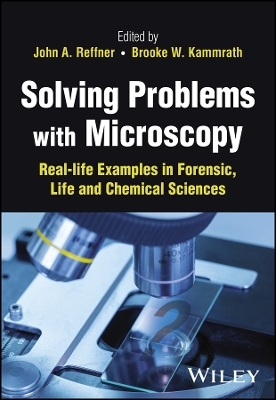
Solving Problems with Microscopy
John Wiley & Sons Inc (Verlag)
978-1-119-78820-1 (ISBN)
This book takes a “why to” rather than the common “how to” approach to demonstrate the capabilities of microscopy to solve problems. It provides entertaining and informative case examples and lessons regarding the unique value the microscope brings to problem solving by experienced scientists in various industries, including criminal and civil forensic science, manufacturing, environmental science, pharmaceutical science, cultural heritage, and biological sciences. Sample topics covered in this learning resource include:
History of problem solving with microscopy
Fortune favors the prepared mind
The value of multiple associations
The importance of context
Knowing your limitations (i.e. knowing what you don’t know)
Microscopists and other professional scientists who use microscopy can harness the information in this book to make better and more informed decisions by improving their problem-solving strategies and processes.
John A. Reffner is a Professor Emeritus of Forensic Science at John Jay College of Criminal Justice with over sixty years of experience working with microscopy. He was instrumental in the development of infrared microspectroscopy, being the inventor of 10 U.S. patents on this technology. He is the Past-President (1979) of the New York Microscopical Society (NYMS). Brooke W. Kammrath is a Professor of Forensic Science at the University of New Haven and Executive Director of the Henry C. Lee Institute of Forensic Science. She also serves as a scientific consultant and expert witness for both criminal and civil cases. She is the Past-President (2017–2019) of the New York Microscopical Society (NYMS).
List of Contributors x
Foreword xii
Preface xvi
Abbreviations xvii
Introduction 1
1 Discovery with the Light Microscope 8
1.1 Hooke, Leeuwenhoek and the Single Lens 10
1.2 Single-lens Microscopes come of Age 14
1.3 Light Microscopes in the Modern Age 17
2 When Problem Solving, Exercise the Scientific Method at Every Step 22
2.1 The Buttonier Case 23
2.2 The Leaky Polio Virus Dispettes 28
2.3 The Green River Killer 32
2.4 The Unfortunate Failure of the Dragline Excavator 40
2.5 The Bodega Burglary 42
3 Images Are Real Data, Too 46
3.1 Mesothelioma Linked to Asbestos 49
3.2 Talc Case 54
3.3 Ford Pinto Case 57
3.4 Uncovering a Moose Hair Cover-up 61
3.5 Carbon Black and Tire Rubber Problems 63
3.6 Optical Microscopy Takes Center Stage: Melamine in Pet Food 67
3.7 Characterization of Foreign Particulate in Pharmaceuticals 77
4 The Microscope as a Compass 87
4.1 Hair Extension Case 88
4.2 Blue Yarn Case 91
4.3 eBay Evidence 93
4.4 An Attractive Contamination 96
4.5 Identifying Metallic Particulates in Pharmaceutical Sample Holders 97
4.6 15th-Century Block Books at The Morgan Library & Museum: The Role of Microscopy in Unraveling Complex Ink Formulations 104
4.7 The Critical Value of Microscopy within Pharmaceutical Development 110
5 Rely on the Fundamentals 120
5.1 A Mouse, a Soft Drink Can … and a Felony 121
5.2 Goodrich Corrosion Problem 129
5.3 The Perils of Forgetting the Fundamentals in Criminal Cases 131
5.4 Super Bowl White Powder Attacks 2014 134
5.5 College Drug Party 137
6 Fortune Favors the Prepared Mind 139
6.1 The NASA Problem 140
6.2 A Train Engine Contamination 142
6.3 Mianus River Bridge Collapse: Why Do You Need a Microscope to Determine Why a Bridge Fell Down? 145
6.4 Microcrystals Tests for Drugs Using the Chemical Microscope (PLM) 152
7 Know Your Limitations 157
7.1 Why Does Guercino's Samson Captured by the Philistines Have a Grainy Surface Texture in Some Paint Passages? 158
7.2 The Secrets of Hair 163
7.3 A Connecticut Murder Case 171
8 The Resonance Theory of Experiments 175
8.1 The Red Hooded Sweatshirt 176
8.2 Florida Arson Case 179
8.3 The Multimillion-Dollar Waterproof Failure 182
9 Value of Multiple Associations 202
9.1 Atlanta Child Murders Investigation 203
9.2 Hog Trail Murders 210
9.3 Hoeplinger Murder 213
9.4 Jackson Pollock Authentication 221
10 Defining Meaningful Differences 238
10.1 The Yellow Rope 240
10.2 Lightning Strike 243
10.3 Raman Microprobe Characterization of ZrO2 Inclusions in Glass Lightguides 247
10.4 Whose Soot Is It Anyway? 253
11 The Importance of Context 267
11.1 GE Capital White-Powder Case 268
11.2 XB-70 Valkyrie Fuel Line 270
11.3 Cocaine Case 272
11.4 The Preppy Murder 274
12 Conclusion 282
12.1 Introduction 282
12.2 Solving World Problems 283
12.3 Lifelong Learning 287
12.4 Continued Evolution of Microscopy and Photonics 288
12.5 Final Thoughts 290
Index 292
| Erscheinungsdatum | 21.10.2022 |
|---|---|
| Verlagsort | New York |
| Sprache | englisch |
| Maße | 170 x 244 mm |
| Gewicht | 765 g |
| Themenwelt | Naturwissenschaften ► Biologie |
| Naturwissenschaften ► Chemie | |
| Technik ► Maschinenbau | |
| ISBN-10 | 1-119-78820-X / 111978820X |
| ISBN-13 | 978-1-119-78820-1 / 9781119788201 |
| Zustand | Neuware |
| Informationen gemäß Produktsicherheitsverordnung (GPSR) | |
| Haben Sie eine Frage zum Produkt? |
aus dem Bereich


